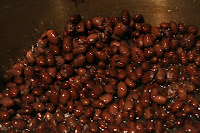To recap: We bought this whole, uncooked pig and roasted it. Which was lovely and difficult and I'm so glad we did it and I'll never do it again, and everyone had a good time and ate lots of pork. And then, and you probably saw this coming, we had all this pig left over.
Or, to be more precise, we had whole pig carcass with all the pork eaten off it. The bones, the ribs, the head, the liver, the feet...those things we had.
Well, and I guess there was some actual pork left too.
So, after weeks of planning a pig roast, we suddenly found ourselves with about twenty pounds (give or take ten pounds) of pig bits that needed to be dealt with.
First we cut up the pig carcass. After the roast, we'd just put the whole thing in a garbage bag and left it in the fridge, so there was quite a lot of cutting and sorting to do. I don't have any photos of that (lucky you), but it was a huge pain and took the two of us about two hours. As is true of this whole project, had we known what we were doing, it would have been a simple process and taken about twenty minutes.

 After our carving ordeal we got hungry and ate liver, onions, and pig cheek for our afternoon tea. And, well, about the liver. It tasted wonderful on the day of the roast, covered in the citrus-y marinade, but most of the delicious seemed to have dissipated in the meantime. Liver is sort of gross, even when you're a grown-up.
After our carving ordeal we got hungry and ate liver, onions, and pig cheek for our afternoon tea. And, well, about the liver. It tasted wonderful on the day of the roast, covered in the citrus-y marinade, but most of the delicious seemed to have dissipated in the meantime. Liver is sort of gross, even when you're a grown-up. With that, we'd gotten rid of the liver and the cheeks, which wasn't really making much of a dent in the huge pile of pig pieces. So we filled up a stock pot with meaty bones and feet, threw in some onions and bay leaves, and boiled the hell out of it.
The resulting stock was so thick (and the refrigerator so cold) that it congealed overnight. Which made bagging it for the freezer extra easy!


The thing about pork stock is that it really isn't a good soup stock. It's thick, it's overwhelmingly flavorful, and it's sort of... intensely porky. Extremely good for cooking beans. Not so good for a nice noodle soup. Luckily one of my favorite, freezable, hearty foodstuffs involves lots of pork and beans.
Feijoada is a Brazilian staple. Like all regional specialties, there's only one way to make it, and everyone in Brazil has their very own, totally authentic way of doing so. Luckily they do usually agree on two things: black beans and pork.
And onions, because everyone loves onions. We kept it real simple: Cook two pounds of black beans with some pork stock. Sauté all the onions left over from the pig roast, add a couple of pounds of chorizo that you picked up at the corner store and about an equivalent pile of pork that you just spend hours chopping off a pig carcass. Everything should be bite-sized pieces. Add it to the beans with some bay leaves. Cook for awhile.

After eating it in your Pre-Modern Europe class, decide it needs a salty/smoky flavor. Buy a package of bacon. Add it to the pot. Cook for awhile.

Now put it in your fridge, next the pot of pork stock, the tupperware of pork fat, and the bowl of pork pieces.
Come back next week for my exciting foray into a rigid kosher diet! This new religious adherence will be a desperate and terribly transparent ploy to avoid all the pork that's invaded my life.








"Come back next week for my exciting foray into a rigid kosher diet!"
ReplyDeleteRube, you are truly extraordinary. comedy gold.
Ruby, Love your blog! Loved the entire story about the pig roast. Have a great weekend!
ReplyDeleteYou forgot the farofa :(.
ReplyDeleteSweet! Just so happens we find ourselves in the same "pig -filled" boat! The pig roast was great..but, uhm, can i really throw away an entire pig carcass? Not this girl!
ReplyDeleteSo,thanks for the tips and tricks for making the stock...thinkin' a nice gelatinous base will be perfect for a chili perhaps... going to get to roasting and a boiling them bones (and head)! Thanks again!
Chili would be perfect. Glad I could help!
ReplyDelete